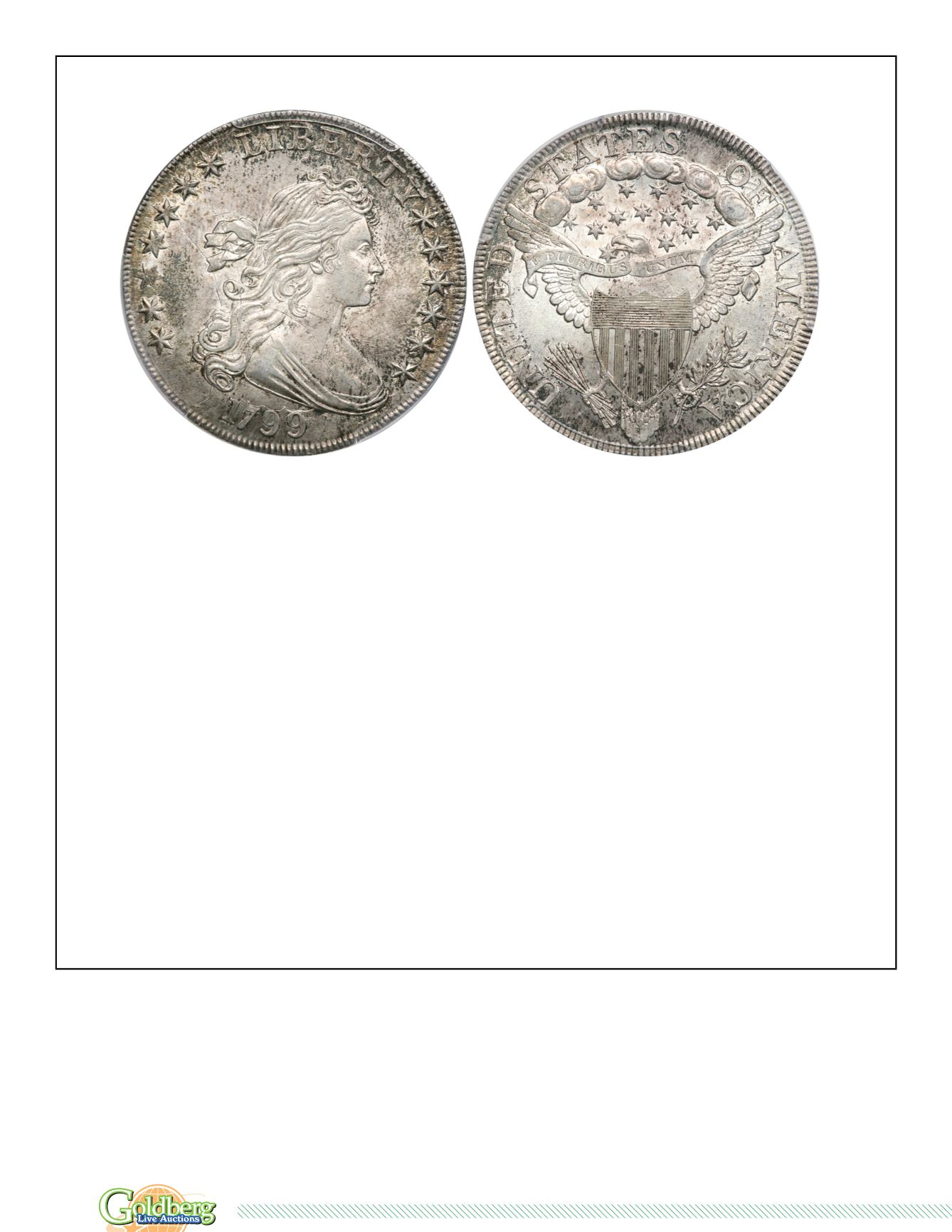
148
|
Dollars
W
ONDERFUL
1799 D
RAPED
B
UST
D
OLLAR
Enlargement
905
1799 B-16, BB-158 Rarity 2
.
PCGS graded MS-64.
CAC Approved
. A remarkable early Heraldic Eagle Dollar irrespective of type, date
or die variety, this handsome 1799 Draped Bust shimmers with a hard, satiny sheen as the view rotates it under a light, admiring in the pro-
cess its fine detail and incredible mint bloom. Much of the reverse is brilliant, and speckled in olive-russet and charcoal-gray patina generally,
mainly confined to the periphery. The obverse is more extensively toned, although here too dappled olive-russet and charcoal-copper patina
are mostly present around the periphery. We see some delicate champagne-pink undertoning throughout the obverse that is really not evi-
dent on the other side of the coin. Stars 3-4 on the obverse have the only noticeable lack of detail, leaving the remaining devices with bold-
to-sharp definition. Much of the coin’s beauty and alluring eye-appeal result from a fairly well centered strike on both sides, giving the whole
ensemble a balanced appearance; only in the 10-11 o'clock area on the reverse do the dentils become a bit tight.
Among the more plentiful die marriages of the 1799 Draped Bust Dollar, BB-158 is readily obtainable in all grades up to and including About
Uncirculated. The variety remains rare in Mint State, however, the near-Gem we are offering here certainly qualifies for the upper reaches of
“Condition Census.” It also ranks among the finest-known survivors of the issue as a whole, perfectly enhancing its desirability for inclusion in
the finest rare coin portfolio. One would hope for and expect that there are no conspicuous abrasions on either side, and this is the case. We
are unable to offer any pedigree markers aside from the aforementioned pattern of toning. Perhaps a little toned spot below the eagle’s beak,
along with the speckled toning on either side.
Pop 10; 6 finer, 1 in 64+, 2 in 65, 1 in 65+, 2 in 66
. (
PCGS # 6878
)
Some events of the Year 1799, as gleaned from the Bowers-Borckhardt silver dollar encyclopedia: On December 14, 1799, George Washing-
ton died at Mount Vernon, his Virginia home. Four days later the news reached Philadelphia. In a speech before Congress, Henry Lee
described the deceased as "First in war, first in peace, and first in the hearts of his countrymen." Early the following year, speeches, eulogies,
and parades were given in Washington's honor, and medallic remembrances were produced, the most famous being the varieties of cent-sized
tokens made in copper, white metal, silver, and gold by Jacob Perkins of Newburyport, Massachusetts, and bearing the inscription, HE IS IN
GLORY, THE WORLD IN TEARS. The memory of the first president would endure, and as one medal noted, "time increases his fame."
A census conducted by Spanish authorities in lower Louisiana revealed that there were 42,375 inhabitants, two-thirds of whom were of Euro-
pean extraction. The Baltimore American became the first publication to record congressional debates and speeches in detail. In Dalton, Mas-
sachusetts, the Crane paper mill was established; it would later furnish sheets for the printing of bank notes and currency.
In England, chemist Humphry Davy inhaled nitrous oxide, or laughing gas, and reported that it made him insensitive to pain; the gas later
came into use as an anesthetic. The first British income tax passed Parliament. In Egypt, Champollion discovered the Rosetta Stone, which
had been carved with inscriptions in three different languages; when deciphered, it became the key to decoding ancient Egyptian writing.
Estimated Value ........................................................................................................................................................$100,000 - 110,000


